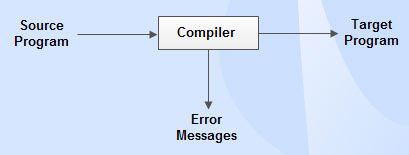A program written in high-level language is called as source code. To convert the source code into machine code, translators are needed.
A translator takes a program written in source language as input and converts it into a program in target language as output.
It also detects and reports the error during translation.
Roles of translator are:
• Translating the high-level language program input into an equivalent machine language program.
• Providing diagnostic messages wherever the programmer violates specification of the high-level language program.
Different type of translators
The different types of translator are as follows:
Compiler
Compiler is a translator which is used to convert programs in high-level language to low-level language. It translates the entire program and also reports the errors in source program encountered during the translation.

Interpreter
Interpreter is a translator which is used to convert programs in high-level language to low-level language. Interpreter translates line by line and reports the error once it encountered during the translation process.
It directly executes the operations specified in the source program when the input is given by the user.
It gives better error diagnostics than a compiler.

Differences between compiler and interpreter
SI. No | Compiler | Interpreter |
1 | Performs the translation of a program as a whole. | Performs statement by statement translation. |
2 | Execution is faster. | Execution is slower. |
3 | Requires more memory as linking is needed for the generated intermediate object code. | Memory usage is efficient as no intermediate object code is generated. |
4 | Debugging is hard as the error messages are generated after scanning the entire program only. | It stops translation when the first error is met. Hence, debugging is easy. |
5 | Programming languages like C, C++ uses compilers. | Programming languages like Python, BASIC, and Ruby uses interpreters. |
Assembler
Assembler is a translator which is used to translate the assembly language code into machine language code.

 Dinesh Thakur holds an B.C.A, MCDBA, MCSD certifications. Dinesh authors the hugely popular
Dinesh Thakur holds an B.C.A, MCDBA, MCSD certifications. Dinesh authors the hugely popular